Red Fox Sexing
The question of how to tell the sex of a fox in the field is one frequently asked, but to which there isn't a straight answer. Over the years, many authors have professed sure-fire methods for telling vixens (females) from dogs (males), but in practice there is very little sexual dimorphism in Red foxes (i.e. the males and females look very similar). Some proposed methods of separation, the origins of which are lost in antiquity, have since been proven untrue. A white tip on the tail isn't, for example, indicative of either sex -- this "brush tag" can be present in both dogs and vixen, or may be absent altogether. Similarly, a proportionally shorter coat and squatting while urinating are often, but not exclusively, associated with vixens. Indeed, in his 2000 book, My Life With Foxes, New Forest naturalist Eric Ashby noted how his captive dog fox would squat like a vixen, depositing only a little scent, for most of the year and only cocked his leg to urinate during the breeding season.

In his 1906 Foxes at Home, Colonel Talbot described how vixens carry their heads higher than dogs, have thinner necks and hold their brushes differently. Subsequent authors, Roger Burrows for example, have failed to notice any significant differences in those features. Burrows also mentioned how some hunters claim to be able to sex a fox based on close study of its paw print (that of a vixen being smaller than that of a dog), but pointed out that this was not something he could ever do.
Brian Vezey-Fitzgerald, in his 1968 Town Fox, Country Fox, provided several intimations given by others on how best to sex a fox in the field, adding to the aforementioned suggestions that there is apparently a belief among country folk that golden cubs are always vixens. Fur colour is not sexually dimorphic in foxes and, as such, golden cubs can be of either sex. Size is sometimes used to infer sex, insomuch as dogs tend to be larger and (approx. 17%) heavier than vixens, as are the type of calls each sex make. With the possible exception of the wow-bark call, however,these are generally unreliable indicators of sex. Vezey-Fitzgerald came to the conclusion that many naturalists still hold today:
"I remain firmly of the opinion that you cannot tell dog-fox from vixen at sight in the field with any certainty."
Similarly, in 2008, Norfolk-based naturalist John Hampshire described watching two foxes in a post-copulatory lock being pestered by a third male and wrote:
"As an aside, it was interesting to see how close in size the three animals were, I don't know whether the vixen was particularly large for her sex but she appeared only marginally smaller than the two dogs. It made me realise that those people who confidently sex every fox they see are probably making a lot of mistakes."
There are, nonetheless, a couple of well-cited methods that are apparently fairly accurate. The first, and by far the most straightforward and obvious, is to look for the cream-coloured fur of the scrotum (which identifies a male) or the teats of a lactating female; these features are, however, not always apparent, being prominent only during the breeding and cub-rearing seasons, respectively.
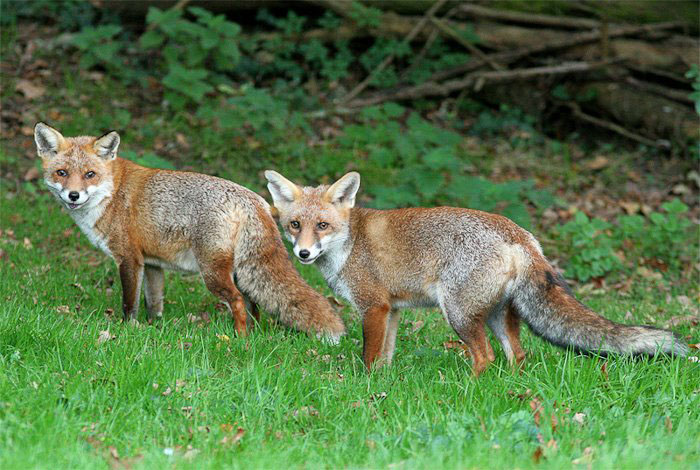
The second method involves looking at the face of the animal; more specifically, the breadth of the head and the position of the ears relative to the nose. In 1962, the eminent naturalist and fox farmer Henry George Hurrell noted that males generally have broader heads and thicker muzzles than females and, in 1968, Burrows described how this broadness causes the ears of a dog fox to form a W-shape when viewed head-on, whereas they form a V in vixens whose heads are generally more triangular in shape. Several authors have apparently used these features to successfully sex foxes in the wild and Stephen Harris included it in a brief article to the May 2007 issue of BBC Wildlife Magazine, although in The Red Fox, Lloyd cautioned:
"There certainly is such a difference, but it is not often easy to distinguish the sexes in isolation."
Even when the sexes are together, head broadness may not be a reliable guide as the photo comparison below shows. Photographer and fox-watcher Alannah Hawker, who kindly provided me with one of the photos, told me:
"I've found the head sizing as not much use, we had a female a few years ago with a very broad head, but she was definitely a vixen.".
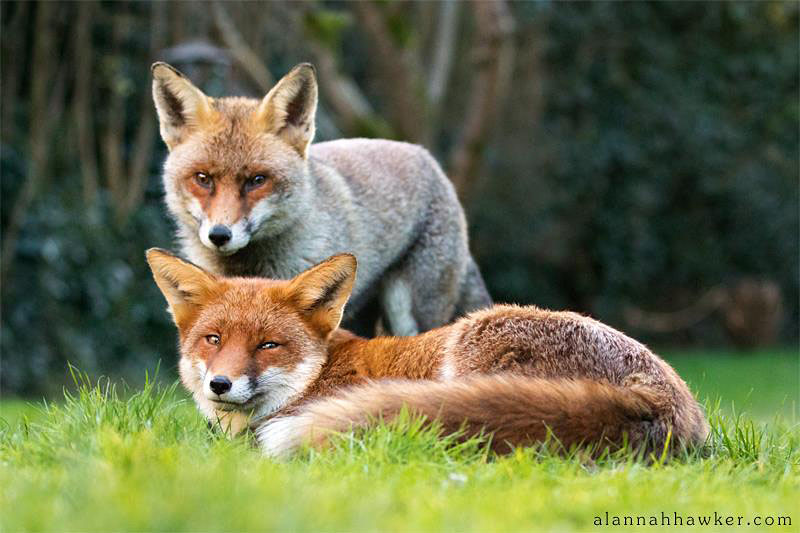
The thickness of the neck can sometimes be used in conjunction with head broadness to identify a male. In the example below, the male has a substantially bulkier neck than his mate, which is a combination of fur and hypertrophied musculature. This does, however, vary on an individual basis and, presumably, in accordance with dominance.
If you happen to be examining the skull of a fox and have a pair of calipers to hand, taking some measurements and applying them to a simple calculation allows for the separation of vixens and dogs in 70% to 90% of cases. Early work on farmed and wild foxes by Canadian researcher Charles Churcher revealed that taking three measurements of the skull (the total length, zygomatic width and mastoid width -- click link below) allowed the correct sexing of 101 of 113 specimens (i.e. was about 90% accurate). Churcher looked at various measurements of the skull and found that he couldn't accurately separate males from females based on a ridge of bone that runs along the top of the skull called the sagittal crest.
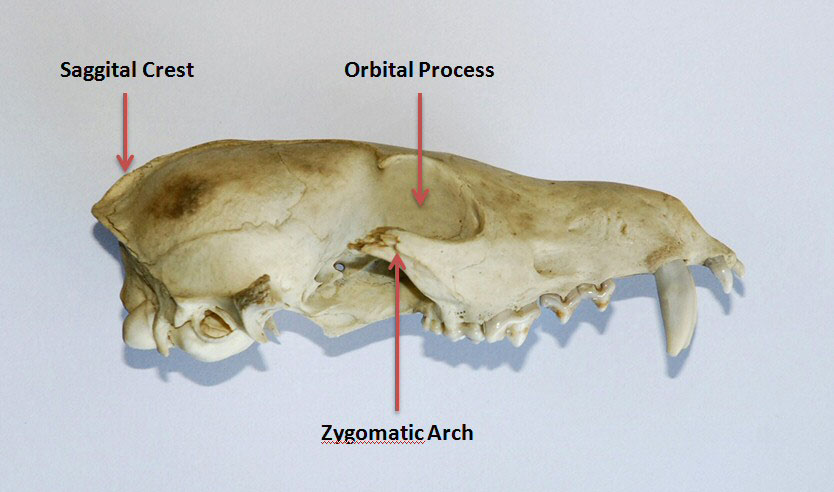


Subsequent authors have since found skull measurements to be of considerable use and, in their contribution to the fourth (2008) edition of Mammals of the British Isles, Stephen Harris and Phil Baker note that, in animals 10 months and older, males can be separated from females by the sagittal crest with an accuracy of 70%. Harris and Baker do note, however, that the crest is poorly developed or absent in males younger than 10 months, causing their skulls to look like those of vixens. This is a finding echoed by many naturalists, who note that young males have faces more similar to vixens; the skull broadening with increasing age.
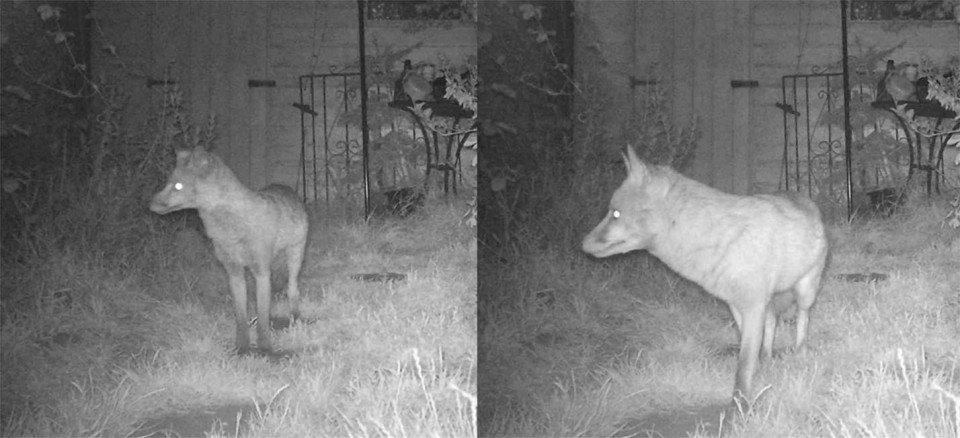
In a 1980 paper to the Journal of Zoology, M.A.F.F. biologists L.W. Huson and Robert Page noted similar age-related variation; they found that male skulls changed more with age than those of vixens. More recently, a team of Czech researchers found that, in both sexes, the skulls grow rapidly in length during the first six months of life, reaching full length at around this age; the skull then continues to grow in width. The researchers also noted some differences between the sexes: in males the jugular breadth, for example, increases after six months old, while in the female it does not. Consequently, sexual dimorphism was evident in skulls at the age six-and-a-half months to one year old.
In an earlier paper to the same journal, Huson and Page were able to correctly sex 80% of the 192 skulls they collected from south-east England using only two measurements (total length and palatal length) and, by adding two more measurements (zygomatic width and condylo-basal length) they were able to correctly sex 88% of 379 Welsh fox skulls. Similar success was achieved by John Lynch working in north-east Ireland during 1996.
In his study of 204 adult Red fox skulls held at the Ulster Museum in Belfast, Lynch found that dog skulls were larger, longer and had a narrower post-orbital constriction than vixen skulls; based on these characters, he was able to correctly sex 87% of his skulls. Lynch considered that the narrower inter-orbital constriction could permit the dog fox a greater bite force and therefore allow it to handle relatively larger prey. If you're interested in the calculation Lynch presented click the link below.
Sexing Foxes Based on Skull Measurements
In a 1996 paper to the journal Biology and Environment, University College Dublin zoologist John Lynch studied the skulls of 210 foxes in the collections of Ulster Museum in Belfast. Lynch came up with a mathematical discriminant function to predict the sex of a fox based on its cranial morphometrics. In other words, he devised an equation that can give you a good idea of whether the fox skull in front of you came from a male or female animal.
Lynch presented this equation:
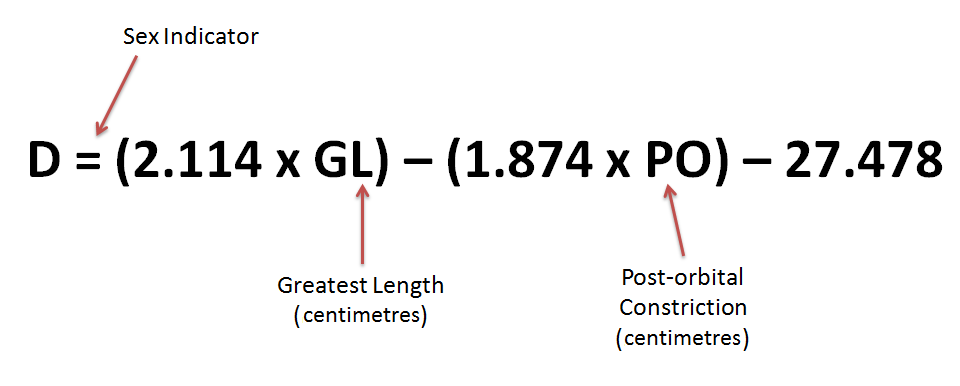
We don't need to worry about the maths of it (which is just as well, as I'm no mathematician!), all we need are two measurements to get us our D value. We need the total length of the skull and the constriction in the top of the skull just behind the orbital processes; both in centimetres. Here's what I mean:

So, if we take these two measurements and plough them into the equation, we get the following:
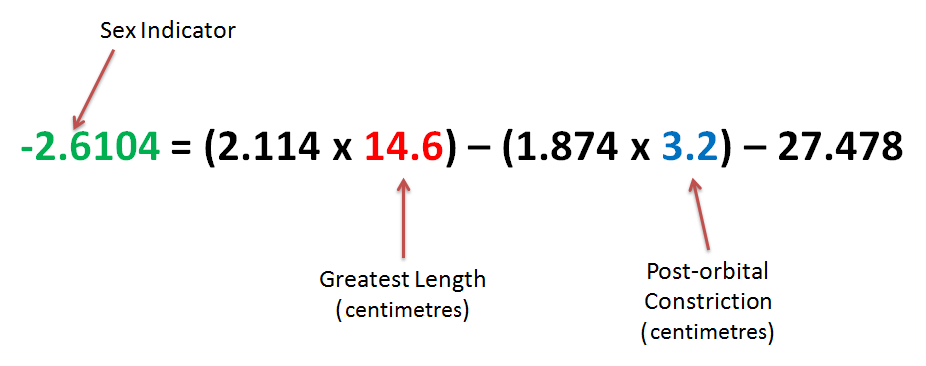
According to Lynch's data, a D (sex indicator) value of greater than zero (i.e. a positive number) indicates a male, while less than zero (a negative number) indicates a female. Therefore, in our example, we most likely have the skull of a vixen. This method isn't foolproof, but Lynch was able to correctly sex 86% of vixens and 87% of dogs.
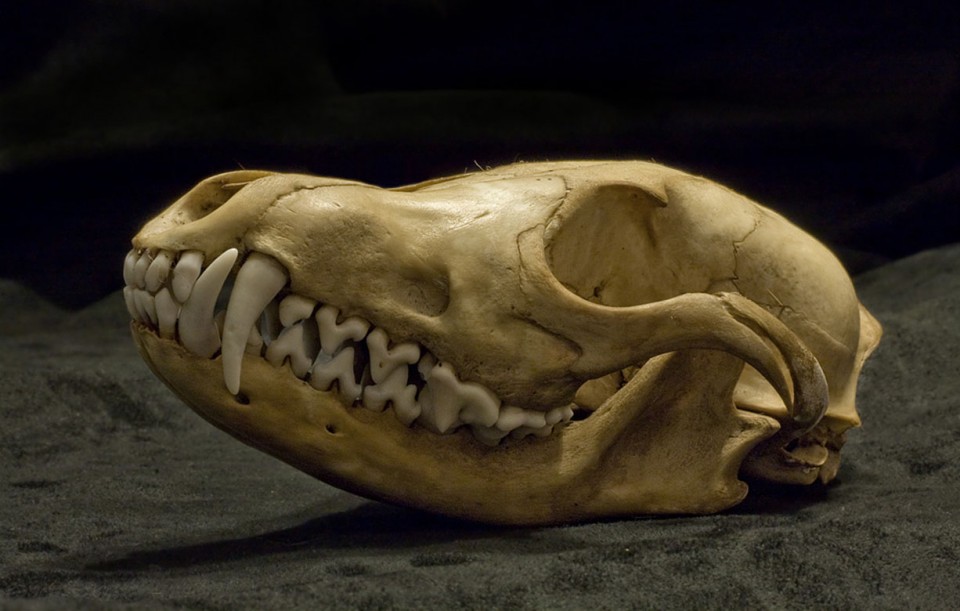
The Czech research mentioned earlier found similar results to those reported by Lynch and, in a 2010 paper to Folia Zoologica; they noted that male skulls were significantly larger than those of females in all measurements they took except one: the postorbital breadth, which was wider in females than males. The anatomists wrote:
"The narrower postorbital constriction and a longer and higher sagittal crest enlarge the area for muscle insertion and the male jaw becomes stronger."
In other words, having this narrower area of bone just behind the eye sockets leaves more room to anchor a large masseter (chewing) muscle, thereby potentially allowing the fox to take relatively larger prey. The suggestion is that this may allow for some niche separation between the sexes, i.e. males taking larger prey items than females, and more recent data suggest that, in some populations at least, males certainly have a wider diet breadth than females. Working in northeastern Poland, for example, Dorota Kidawa and Rafal Kowalczyk found that the diet of both adult and juvenile males was significantly broader than that of females, with females taking mostly voles while males took a wider range of mammals and birds. In their 2011 paper to Acta Theriologica, Kidawa and Kowalczyk wrote:
"We noted that the diets of adult males and young foxes converged; both had large food niche breadths and hunted bigger and potentially more difficult to obtain prey such as birds and other mammals, whereas females concentrated mainly on small mammals."
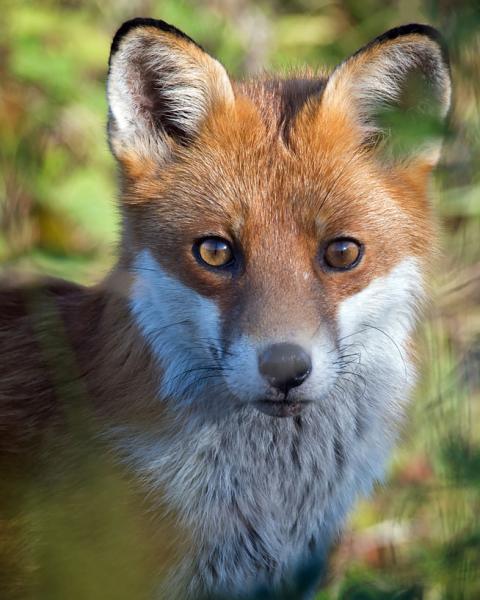
A similar observation was made by Jesse Forbes-Harper at Murdoch University and her colleagues recently. In a 2017 paper to the Journal of Zoology, Forbes-Harper and her co-workers present their analysis of skull morphometry and diet from 540 foxes shot as part of a government-run control programme in Australia. The researchers noticed a dietary separation between males and females, with dog foxes taking more sheep carrion (47-65% of the diet by volume) while adult vixens took more mice and invertebrates.
Interestingly, Forbes-Harper and her team also observed that males had generally larger skulls, with higher sagittal crests that allowed for greater attachment of the temporalis muscles that open and close the jaws. The result was that male foxes had a greater estimated bite force than females. Very approximately, based on the box-plot they included in their paper, males had a bite force between about 218 and 290 Newtons, while the female range was roughly 195-250. When considering only adults (2 years or older), there was a clear separation: most vixens had a bite force between 230 and 250 Newtons, while most males fell in the range 260-290. Forbes-Harper and her colleagues note that fox skulls change as the fox grows up to handle a more carnivorous diet, with relatively larger jaws and a more robust skull.
Finally, it is not just skull measurements that can be used to separate the sexes. In a 2008 paper Elwira Szuma looked at the teeth of just under 3,000 Red foxes collected from across the Northern Hemisphere and found that those of males and females differed from one another, most notably the canines and carnassials; overall, male canines were 3.6% larger than those of females. Szuma also found that there was more of a difference between the sexes in the Palaearctic (Europe and Asia) than in the Nearctic (North American) foxes.